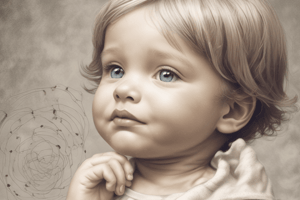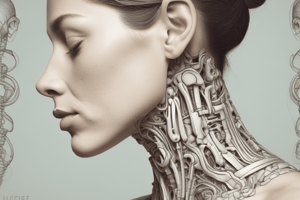Podcast
Questions and Answers
What is the significance of the date mentioned in the content?
What is the significance of the date mentioned in the content?
- It is the date of an important historical event.
- It represents a completion date for a project.
- It indicates a publication or printing date. (correct)
- It marks the start of a new chapter.
Which aspect could potentially impact the understanding of the content in the provided pages?
Which aspect could potentially impact the understanding of the content in the provided pages?
- The type of paper selected.
- The alignment of the text.
- The color of the ink used.
- The formatting of the pages. (correct)
Which inference can be drawn regarding the sequence of page numbers in the content?
Which inference can be drawn regarding the sequence of page numbers in the content?
- Pages are printed in a random order.
- Certain pages might be omitted entirely.
- It indicates chapters that are interconnected.
- Pages follow a consistent numerical order. (correct)
What can be inferred about the resolution of images or text within the provided pages?
What can be inferred about the resolution of images or text within the provided pages?
Which conclusion can be drawn regarding the overall structure of the content from the page numbers provided?
Which conclusion can be drawn regarding the overall structure of the content from the page numbers provided?
Flashcards
Hard Drive
Hard Drive
A large, strong, multi-purpose storage device.
RAM
RAM
Temporary memory used by the computer to store frequently accessed data.
Motherboard
Motherboard
A circuit board that connects all the parts of a computer.
Monitor
Monitor
Signup and view all the flashcards
USB Drive
USB Drive
Signup and view all the flashcards
Study Notes
Pediatric Conditions
-
Torticollis (Wryneck): A condition of SCM muscle tightness, often congenital, causing head tilting and limited range of motion. Congenital is the most common type. Acquired torticollis is spasmodic. Right torticollis affects flexion, right side-bending, and left rotation. Treatment involves stretching to extension, left side-bending, and right rotation.
-
Plagiocephaly: Skull flattening due to prolonged positioning. Positional plagiocephaly is common, often due to right CMT. Right-sided plagiocephaly displays right occipitoparietal flattening and left occipital bossing with anterior right ear and frontal bossing displacement.
Cerebral Palsy
-
Pathology: Nonprogressive encephalopathy, mainly due to birth trauma, or hemorrhage, hypoxia, or malformations in the CNS. Classified by body region affected (monoplegia, diplegia, hemiplegia, or quadriplegia).
-
Movement Disorders: Spasticity, velocity-dependent increase in tone affecting anti-gravity muscles (due to motor cortex lesions) and abnormal postures (flexion/extension). Additional types listed as dystonia, and ataxia.
Spina Bifida
- Pathology: Neural tube defect, causing spinal cord and/or vertebral malformation, often linked to maternal folate deficiency, infections, and/or substance abuse. Types include myelomeningocele (severe with open lesions) and spina bifida occulta (closed lesions with no SC involvement.)
Arthrogryposis
- Pathology: Nonprogressive condition with multiple joint contractures and muscle weakness, appearing at birth due to multiple joint limitations.
Autism Spectrum Disorder
- Pathology: Developmental disorder appearing within the first 3 years, generally affecting social communication and interaction, and sometimes play skills. Affects more males.
Down Syndrome
- Pathology: Extra copy of chromosome 21, leading to developmental delays (especially gross motor) and other potential health issues (including hypotonia, ligament laxity, possible heart defects).
Duchenne Muscular Dystrophy (DMD)
-
Pathology: X-linked recessive, affecting males— Dystrophin gene mutation results in sarcolemma permeability and muscle destruction.
-
Impairments: Progressive muscle weakness, often starting in the proximal limbs and progressing distally, resulting in pseudohypertrophy, cardiomyopathy (common), and contractures.
Becker Muscular Dystrophy (BMD)
- Pathology: Slower progression of DMD, with wheelchair usage typically starting in the late 20s.
Brachial Plexus Injury
- Pathology: Brachial plexus injury during childbirth, resulting in Erb (upper arm) or Klumpke (lower arm) palsy due to traction. Results in paralysis or sensory deficits in the affected arm.
Studying That Suits You
Use AI to generate personalized quizzes and flashcards to suit your learning preferences.




